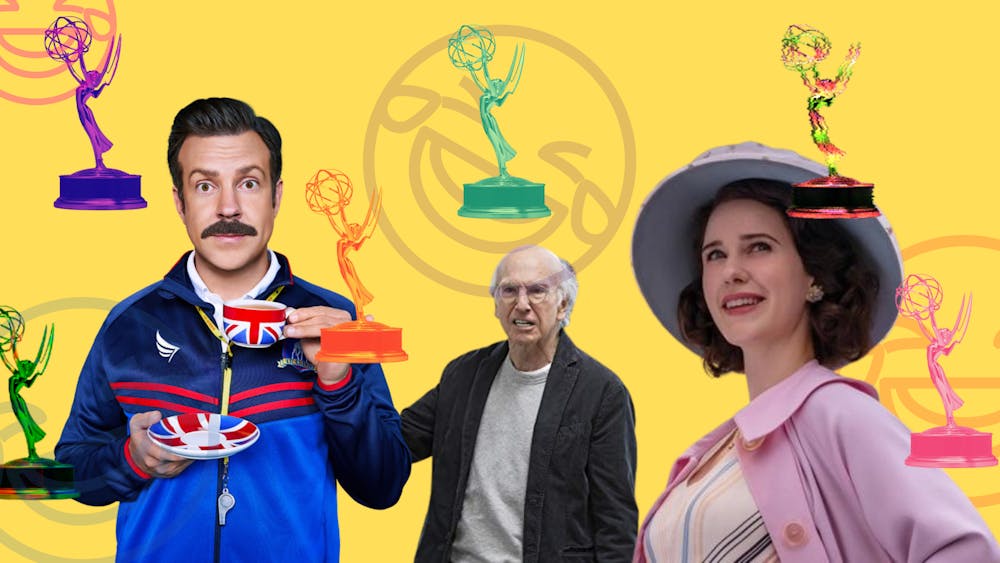On Feb. 9, 1958, Steve Allen and the guests of his Sunday night variety series marched through the NBC studios with Dinah Shore over to the set of her own show, singing and dancing all the way. The group followed cameras around hallway corners while performing Allen’s “This Could Be The Start of Something Big.” The final product survives in video form, a wildly impressive technological feat for its decade.
What’s most stunning about this short clip, however, is the intensity with which the blurry kinescope and staticky lyrics captured the optimism, excitement, and pioneering spirit of television in these early days. This artifact captures the sense that the only direction to go was up.
The hold that comedy television would have on 20th century American culture was reflected in its trailblazers. Allen, Ernie Kovacs, Sid Caesar, Lucille Ball, and many others shaped variety, sketch, talk, and situational comedy, the formulas of which have been perfected and subverted ever since. The competition among networks and later explosion of cable meant that different comedic styles ebbed and flowed, yielding a diverse lineup of entertainment.
One would expect that today, when there are endless possibilities and platforms for content, competition would once again breed comedic variety. Yet, when observing the critically successful series of our current decade, the opposite seems true: Stylistically, television comedy has become limited.
It’s easy to look at the current comedy offerings solely through the lens of what’s absent. When examining this year's nominees for the “Outstanding Comedy Series” Emmy, it’s impossible to ignore the lack of multicamera sitcoms, a genre that swept the category during the heyday of NBC’s “must–see TV” in 1987. Today’s shows are all single–camera and fit fairly neatly into the categories of comedy–drama, mockumentary, and satire. There isn't anything on television even close to the diversity of CBS’s Saturday nights circa 1973–74—forget a night with four wildly unique sitcoms and a top variety show.
The forces shaping today’s popular television aren’t random, but new networks of shared culture, social spheres, and technology. Even comedies like Hacks, Ted Lasso, and The Marvelous Mrs. Maisel are subject to the same pressure as dramas like Stranger Things and Squid Game to provide concise and thrilling seasons with clearly recognizable viral moments. While this means less content overall, it also means that the best shows out there are pushing harder to avoid a weak episode.
Regardless of the specific reasons behind the change, a shift toward realism and surrealism is a constant in today’s programming. It could be out of a desire for television characters to more accurately reflect lived experiences as opposed to serving as broader archetypes. The perk of this is that deeper, more true–to–life stories are being told, which beyond providing fascinating material, builds a pathway toward empathy.
We can appreciate these interesting ways television has adapted to our time while acknowledging something is lost. But it’s incorrect to think of television as having moved behind comedy—rather, comedy has moved beyond television.
When Conan went off the air in June of 2021, it felt like the end of another branch of television comedy. Conan O’Brien’s willingness to feature a guest just for laughs, or to create a happy, meaningless bit, was in many ways the last shred of a more comedy–centered talk style. But O’Brien is also only going forward. He’s got an enormously popular podcast, which follows the trend of stripping back to realism and genuineness while still dipping into his broad tendencies.
We’ll always find ways to laugh. Sketch comedy thrives on YouTube and TikTok, even as it fails to maintain a presence on television. I’m excited for a new generation of pioneers to conquer the rugged frontier of entertaining the internet. Between podcasting, short–form videos, livestreaming, and new competition among streaming services, there’s so much to explore.
It could be the start of something big.







